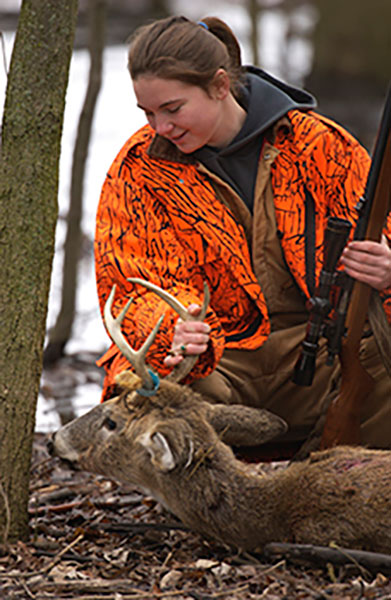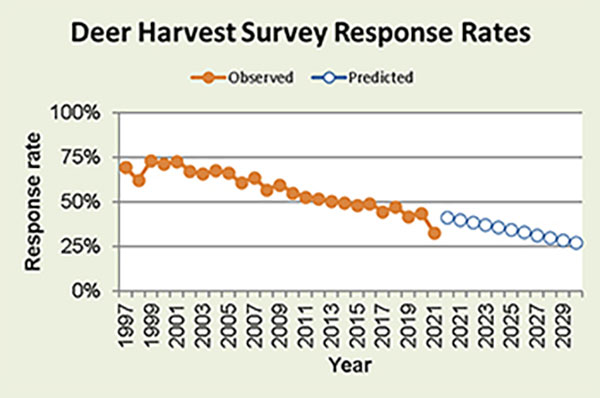MDNR Report
 Deer hunter with harvest
Deer hunter with harvest
Michigan’s annual deer hunting seasons – to many, as much a fall tradition as football, apple cider and pumpkin patches – are once again underway.
Starting with the fall 2022 deer seasons, all hunters who successfully take a deer are required to report it through the DNR’s online harvest reporting system.
This new reporting system is something many hunters have been requesting for several years. During this first fall with mandatory online reporting, conservation officers will focus on educating hunters on the new process, rather than issuing tickets, then begin enforcement next year.
Since the 1950s, the DNR has gathered deer harvest information by mailing surveys to a sample of hunters.
“The new system represents a major change for all Michigan hunters,” DNR deer, elk and moose management specialist Chad Stewart said. “The system will provide us a near real-time estimate of deer harvest as it occurs, something Michigan has never experienced before.”
One of the most important reasons for the move to online harvest reporting, according to Stewart, is more data.
“For anyone out there who is a deer data nerd like myself, a treasure chest of information is right around the corner!”
Better deer data
The DNR has traditionally gathered most deer harvest information through check stations and mail surveys.
Most biological data, like harvest date and location, animal's sex and age, antler beam diameters and antler points, came directly from harvested animals through face-to-face meetings with hunters at check stations. This biological data was used to monitor the size, composition and health of the deer herd.
The DNR has historically sent mail surveys to randomly selected license buyers after hunting seasons have ended and asked them to report information about their hunting activities and harvest. This information gathered from a sample of hunters was used to estimate the harvest and hunting activities for all hunters.
“Both ways of gathering data, check stations and mail surveys, assume that the information collected is representative of all the deer that are harvested, but biases, errors and insufficient data limit the usefulness of the biological data and survey estimates,” Brian Frawley, DNR wildlife biologist and survey specialist, said. “Most data have been collected from hunters who voluntarily provide the information, and these hunters and their harvest may not represent all hunters and their harvest.”
Response rates to the mail surveys have declined from about 75% in the mid-2000s to 33% in 2021 and are expected to decline to about 25% by 2030. Low response rates can lead to an inaccurate, biased estimate of the harvest. Michigan Deer Harvest Reporting Rates
Michigan Deer Harvest Reporting Rates
Because declining survey response rates, which are unlikely to reverse, increase the level of uncertainty with deer harvest estimates, the DNR needed to find another approach.
“We feel it’s important to have confident harvest estimates to make the best, most informed management decisions for one of our most prized natural resources,” Stewart said.
Mail surveys are also expensive and time-consuming. It costs about $173,000 to print and mail a questionnaire to 60,000 deer hunters. The surveys take several months to compile and analyze, with the first survey mailing going out in December and the final report not finalized until the following summer.
Online mandatory harvest reporting will more efficiently collect better, less-biased data at a finer scale and produce harvest summaries sooner than they were available before.
“The speed of the information available, and the amount of information we’ll now have available, is one of the biggest advantages to this new system,” Stewart said. “Our new system, with its corresponding public-facing dashboard, will show hunters every day how harvest is progressing across the season, with up-to-date accounts on total harvest in the state, harvest by county, season harvest and even harvest by day.”
Online harvest reporting makes it cheaper and more convenient for hunters, since they can report harvest via smart device, compared to traveling to a check station. It is also available 24/7 rather than restricted to normal working hours.
The Deer Harvest Report Summary dashboard shows, as of this writing, more than 52,000 harvests reported so far this season, and how many of those deer were antlered, antlerless and taken in each of Michigan’s 83 counties.
The reported harvest for each of the three completed deer seasons was 6,299 for the Liberty Hunt, 3,469 for the early antlerless firearm season and 411 for the Independence Hunt.
Stewart said that if this year’s total deer harvest in those seasons is similar to what it was last year, then the DNR is looking at capturing much of the total harvest with online reporting.
The number of deer harvest reports submitted by Michigan hunters is currently greater than those submitted in other states with mandatory deer harvest reporting and comparable hunter numbers and seasons, like Missouri and Wisconsin. This comparison suggests that most Michigan hunters are complying with the new rules.
“This would, in my opinion, exceed expectations for our first year,” he said.
Currently, there are 14 counties with more than 1,000 deer harvests reported, and the top five counties are Lapeer, St. Clair, Montcalm, Sanilac and Newaygo.
Stewart explained that because of the ability to tie deer harvest to individual licenses, a feature previously unavailable, the new reporting system will give the DNR a better understanding of how many hunters are using one of their combination license tags to take an antlerless deer in the archery season.
“Right now, we know what the estimated antlerless harvest is in the archery season, but don’t understand what licenses hunters are necessarily using to make their harvest decisions,” he said. “We’ll also have a better understanding of reported harvests of button bucks, bucks with shed antlers and bucks with antlers less than 3 inches. Currently, all of those deer are reported as antlerless deer, but we have never been able to fully quantify the values for any of them.”
Another function of the online reporting system is the integration of disease surveillance information. Hunters reporting deer harvested in disease priority areas will receive notifications and instructions on submitting their deer for testing, should they choose to volunteer their deer for either chronic wasting disease or bovine tuberculosis testing.
“The submission process, with hunters receiving a confirmation number from their successful harvest submission, will improve the convenience and flexibility for hunters to submit their deer for testing and allow additional sites, such as 24-7 drop boxes and convenient locations through partnerships with processors and taxidermists, to be used for submission,” Stewart added.
Hunters will have up to 72 hours after taking a deer to report their harvest, either online at Michigan.gov/DNRHarvestReport or through the DNR’s new mobile app.
All successful hunters will be asked to report the unique kill tag license number that was attached to the deer, the hunter’s date of birth, the exact harvest location, the type of deer harvested (fawn, antlered or adult doe), number of antler points (if a buck) and date of kill. Some hunters will be asked additional questions that will help the DNR understand conditions in the field that affect harvest.
So far in the 2022 deer seasons, 81% of hunters reporting deer kills have completed the harvest report in under five minutes.
Hunters can watch short videos on how to report a harvest on the DNR Hunt Fish app and how to report through the eLicense website.
While it has shown to be a quick and easy process, technical assistance is available at a variety of locations around the state or by calling 517-284-9453 during normal business hours.
Answers to frequently asked questions are available on the DNR deer harvest reporting webpage.
Moving online
With its long history of estimating deer harvests through a post-season mail survey, Michigan is behind many other states in adopting online deer harvest reporting technology.
A 2017 study of deer harvest reporting and data collection methods found that most wildlife agencies throughout the U.S. and Canada (64%) used internet harvest reporting as the primary means of collecting deer harvest data.
Reasons cited for using this method included hunter convenience, ease of data collection and analysis, increased hunter reporting rates, greater confidence in hunter harvest data and reduced cost.
Hunters who can’t report their harvest due to a lack of internet access or smart device may get help from a family member or friend with access, by providing them with their kill tag license number, date of birth and harvest location to report on the hunter’s behalf.
Reporting by phone to the DNR is not possible because of the need for accurate harvest location data, which is provided by selecting the location on a digital map. For decades, hunters have pointed out their harvest locations on maps at DNR check stations.
Some hunters have expressed concern about sharing their harvest location using the new digital reporting method, but Stewart stressed the confidentiality and value of that accurate data and how it helps the DNR and, ultimately, hunters.
“While we will have near real-time harvest data available for hunters throughout the season on our website, that data is at the county level,” Stewart said. “Only the DNR will have access to the GPS coordinates of the actual harvest location, which is needed for two very important reasons: more effective disease surveillance, and the ability to build a network of harvest locations over time so we can adapt management guidelines to better align with harvest numbers. That means better overall management recommendations for Michigan’s deer population.”




